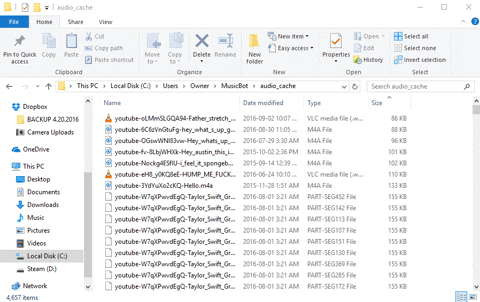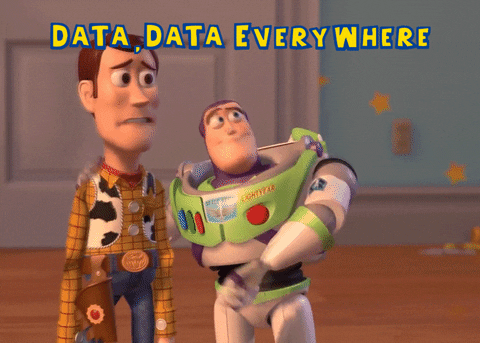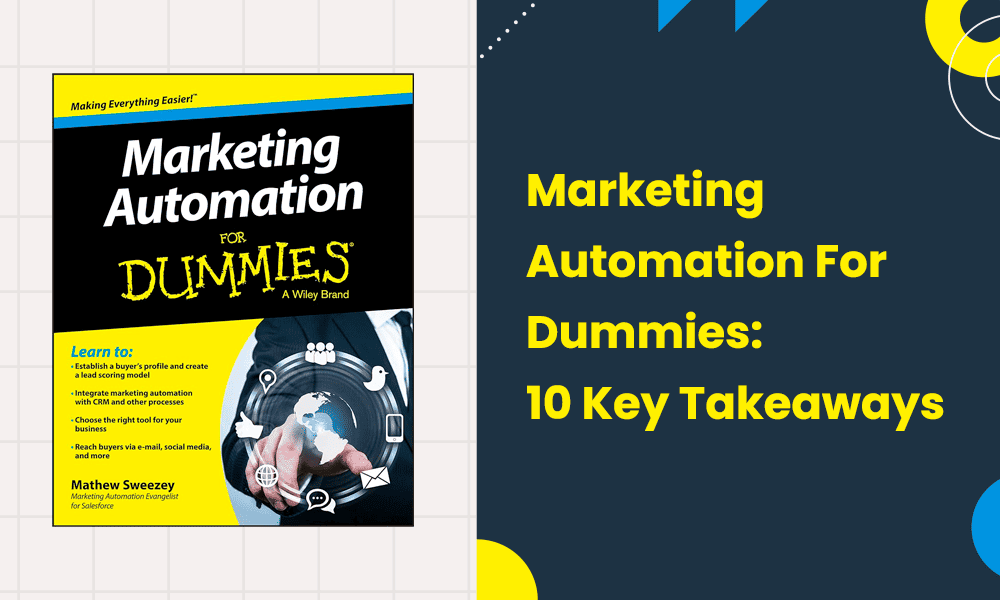If you want to learn something new in an easily explained format, the For Dummies book series is an excellent starting point. Despite the rather abrasive name, these instructional books are beloved for explaining concepts in a straightforward, easy-to-understand way.
You can find a For Dummies title for just about anything you can think of, including marketing automation.
We read Marketing Automation For Dummies, so you don’t have to, and compiled the top 10 takeaways in this book.
Table of Contents
The Low-Down: What Is Marketing Automation For Dummies?
First, here’s a bit more information. Marketing Automation For Dummies is a 2014 book by Matthew Sweezey.

Sweezey is a technology pioneer, podcast host, and marketer. Called “one of the top minds on the future of marketing,” Sweezey is a specialist in media theory and consumer behavior.
He regularly speaks at keynote marketing conferences and shares his written insights in publications like Forbes, The Economist, The Observer, and AdAge.
You can check out his website here and his Twitter account.

Top 10 Tips from Marketing Automation For Dummies
What kinds of pearls of wisdom does Matthew Sweezey have to share with us in his book, Marketing Automation For Dummies?
We won’t leave you on pins and needles any longer. Here are the best insights from the book to incorporate into your future marketing automation campaigns.
1. Start small
Digital marketing automation has so many possibilities it’s natural for marketers to get excited. Your mind can begin racing with all the tasks you want your automation workflows to accomplish, but not so fast!
Putting the cart before the horse can be detrimental as you launch your first automation campaign. In Chapter 3, choosing a marketing automation solution, Sweezey warns against overcomplicating automation.
He writes,
“You should focus on a few short-term goals and a few key features of marketing automation for the best results initially. The rest of your goal can wait until you master your tools and the details of marketing automation.”

So, which goals does Sweezey recommend marketers focus on? He says identifying your marketing goals will help you select an advantageous automation feature.
For instance, if you’re trying to prove your marketing efforts are valuable, Sweezey suggests using automation for customer data collection and reporting.
Here are some other tips:
- Use sales enablement automation to align your marketing and sales teams and ensure the software integrates with your CRM.
- Streamline and consolidate your marketing tools so the new automation software integrates with your most important marketing software solutions.
- Select marketing automation software based on how well the service provider trains you on using it, how flexible the platform is, how easy it is to use, and how much support it offers.
- Prioritize an automation tool’s reporting and lead nurturing if you’re trying to increase your lead generation.
2. Be realistic
Marketers sometimes believe that as soon as they begin automating their processes, massive wealth and a substantial influx of leads will follow. While it would be lovely if true, setting yourself up for such high expectations means you have a great distance to fall.
Another takeaway to highlight from Chapter 3 is the value of planning your expectations with a healthy dose of realism. As Sweezey writes,
“You shouldn’t expect that you can buy a marketing automation solution today and generate an exponential increase tomorrow.”
That’s not how much marketing works, even if you do everything correctly. It can take weeks or months before your hard work begins paying off dividends.
Sweezey says:
“Marketing automation is a discipline just as any other form of marketing is. It requires a full understanding of the technology, the techniques, and the consumer behaviors that drive higher levels of engagement. Setting clear expectations over time helps you judge your performance and pace your implementation.”
Here is how Sweezey recommends keeping your automation goals realistic:
- Include your CRM software in your decision-making, ensuring your setup is compatible with your chosen automation solution.
- Be willing to put the time in. The chapter says, “You have to spend a lot of time on the front end before and during implementation, and less time as you become more proficient with your tool.”
- Commit to the continuity of marketing automation. “Focus on getting up and running today, and then focus on improving over time. Don’t try to be perfect at each step,” Sweezey says.
Read also: The Future Of Marketing Automation: 12 Trends For 2024
3. Know how long implementation takes
Another marketing automation misstep to avoid is underestimating what it takes to set up your new workflow. In Chapter 4, here is the prescribed timeframe Sweezey discusses for each step of the process:
- Connecting
- Website admin and CRM admin – two hours, plus five minutes for each custom field
- Creating a CNAM, authenticating your email marketing automation tool – two hours
- IT resources – one hour
- Importing
- Uploading clean data as a CSV file – 10 hours
- Landing page template – One hour on upper templates
- Autoresponder templates – 20 minutes for each template
- Nurturing templates – 15 minutes for each template
- Email templates – 25 minutes for each template
- Building
- Segmentation ideas – Two hours
- Form layouts – Five hours
- Sales scoring and lead qualifications – Five hours of planning
- Creating outlines for a nurturing program – Five to 10 hours
- Building out quick wins – One hour
Read also: CRM Implementation Guide with Exact Steps
4. Use a standard naming convention for segmented lists

In Chapter 6, Creating Segmented Lists, Sweezey mentions a great point you should keep in mind as you begin accumulating marketing automation data. You should create a naming convention for the files you generate.
Sweezey has some suggestions in his book, like abbreviating terms and attaching those abbreviations to the file name. You might decide that other naming conventions are better, and that’s fine.
What matters is that your entire team is in agreement. Using one naming convention will make it easy for other salespeople and marketers to pick up where you left off without being confused about what each file name means.
You will also find it easier to manage your data and find what you need, even if your company begins accumulating large amounts of data (which will happen eventually!).
Read also: Advanced Segmentation Strategies for eCommerce Emails
5. Make your landing pages “best of breed”
In Chapter 9 of Marketing Automation For Dummies, Matthew Sweezey talks about creating what he refers to as a “best-of-breed landing page.”
Here are the pointers he lists to make your landing pages better:
- Optimizing for too many goals at once takes away from the focus of the landing page and makes it less effective. You’re likely using too many links if your landing page has several goals, which can make your page look spammy and hurt its SEO.
- Utilize dynamic content in your landing pages, which Sweezey defines as “a feature that reads a variable pertaining to each visiting prospect and changes the offer based on this variable.” For example, you can use dynamic content blocks.
- Embed videos into your landing pages to drive up their effectiveness. The video should auto-play when someone clicks on your landing page. Add a call to action in the video.
- Optimize your forms, keeping the content short and asking the right kinds of questions. “A bad question asks for information that people don’t want to provide, such as their phone number. People also dislike any question that you make mandatory,” Sweezey says.
Read also: Data-Driven Marketing Automation For Maximum Impact
6. Use email marketing for nurturing
Nurture campaigns are critical to guiding leads toward a conversion. Building a relationship and providing beneficial, educational information will help the lead feel confident enough to proceed with their purchase.
In Chapter 10, Sending Emails and Nurture Campaigns, Sweezey recommends that a lead nurturing campaign begin with customer segmentation, followed by email templates and dynamic signatures, before working your way up to phone calls.
He also advises keeping the campaign targeted, short, and simple.
Here are Sweezey’s pointers about sending nurture emails:
- Don’t use signature blocks, as they can distract from the signature hyperlink.
- Skip the salutations.
- Write short emails.
- Don’t use bullet points. Sweezey writes, “The problem with bullet points is that if one of them is not something the person cares about, he will dismiss the others.”
- Don’t use special formatting for your emails.
Read also: 11 Affordable, Powerful Customer Journey Mapping Tools
7. Consider account-based lead scoring
In Chapter 12 of Marketing Automation For Dummies, Scoring Leads, Sweezey talks about different types of lead scoring. Many marketers score leads based on their actions (or inactions) and behaviors, but what about account-based lead scoring?
Here is what Sweezey says about it:
“Account-based scoring is a way to identify groups of leads related to the same purchase decision under the same account…Scoring leads based on an account of multiple buyers gives a much clearer picture of the sales readiness of a business and can easily be used as a tool to help you identify the very best sales opportunities rather than just the best individual leads.”
Sweezey notes that account-based lead scoring is helpful for B2B businesses “with complex sales cycles” especially.
Read also: Account-Based Marketing vs Marketing Automation: A Guide
8. Track the right metrics

You can’t determine the success of your marketing automation campaign without reporting, but reviewing unhelpful KPIs is about as bad as never having reported at all. In Chapter 13, Generating Reports, Sweezey suggests the following reporting methods:
- Efficiency reporting, which “compares the number of leads generated to the number of leads lost as a percentage over time.” This metric tells you more than whether you’re acquiring enough leads but what the quality of your leads is like. Low-quality leads who don’t convert are a waste of your time and money.
- Velocity reporting, or “the speed at which a lead moves through your funnel.” Faster is best. Your sales team and marketers must be ready to match a lead’s pace. Identifying which bottlenecks slow down leads is also valuable.
- ROI reporting, which Sweezey says to use “only when money is spent at the start of a campaign and money is returned at the end.” However, he adds that ROI reporting has flaws, including not accounting for the time spent on a campaign and not showcasing a campaign’s full value.
Read also: 9 Problems With Marketing Automation That Impact Business
9. Launch an upsell campaign
Sweezey is an advocate for upselling and mentions the value of specificity in the campaign. Here are the pointers he suggests in Chapter 14: Measuring Your First Campaigns:
- Make the email personal, avoiding bullet points and generalities. Write it “as though you’re writing to a single person.”
- Take an educational slant with your CTA, with helpful content on solving a customer’s problems.
- Don’t use full HTML, but Rich Text instead.
- All emails should come from the contact who initiated the relationship, such as an account representative. This will reduce confusion and make it easier to track email communications for that client.
Read also: Why Companies Need B2B Marketing Automation Today
10. Avoid common mistakes
In Chapter 16 of Marketing Automation For Dummies, Matthew Sweezey lists the top 10 mistakes companies make when using marketing automation. Here’s a rundown of the list. Hopefully, you don’t make many of these gaffes yourself!
- Trying to do too much or promising more than you can reasonably deliver.
- Foregoing content creation and content marketing; Sweezey calls content “the lifeblood of online marketing.”
- Failing to broaden your nurturing campaign, as you should have several.
- Not incorporating social media into your marketing automation.
- Focusing on metrics that don’t matter or have very little bearing on the success of your campaign.
- Waiting too long into the marketing campaign to get your sales team involved. Sweezey says the teams should work concurrently.
- Overbuying tools or vendors.
- Choosing not to audit your business.
- Placing too little value on your website and failing to optimize it in the interim.
- Undertraining your sales team, which hinders their performance and hurts your revenue.
Read also: The Beginner’s Marketing Automation Checklist [101]
Bottom Line
Marketing Automation for Dummies by Matthew Sweezey is an explainer book on all things automation. The book does a great job of going over the ins and outs of automation, with examples and workflows, in a way that even beginner marketers can grasp.
We hope these takeaways whet your appetite and inspire you to check out the whole book!
Want to try out these tips on a free marketing automation platform? Sign up with EngageBay for free and build your first marketing automation workflow 🙂
